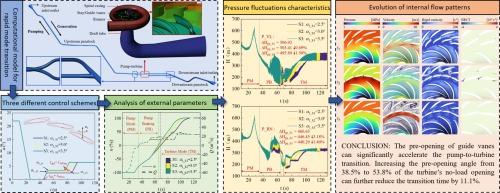不同控制方案下泵-涡轮快速转换过程中的水力不稳定性:改变导叶预开角度
IF 9.9
1区 工程技术
Q1 ENERGY & FUELS
引用次数: 0
摘要
众所周知,抽水蓄能电站能够根据电力系统的要求,灵活地从水泵运行模式过渡到水轮机运行模式,反之亦然。因此,准确预测这种瞬态过程中的水力不稳定性对提高运行稳定性和相关安全性非常重要。此外,适当了解关键控制参数的影响对于优化控制策略也至关重要。有鉴于此,本研究基于数值模拟方法,试图对泵到涡轮机的快速过渡过程进行研究。为此,从外部参数变化、压力波动特性和流型演变机理三个角度,研究了三种不同导叶预开角的控制方案。研究结果表明,在过渡期间,预开导叶可以显著加快转速和流速的变化,从而促进更快的过渡。不同的控制方案在外部参数、压力波动和流动模式上表现出相似的演变趋势,但在时间和幅度上有所不同。将预开角从空载位置的 38.5% 增加到 53.8%,可有效缩短 11.1% 的过渡持续时间,并将无阀区的峰-峰压力波动降低 2.2%。虽然最大正轴向力增加了 16.0%,但增加的幅度仍然微不足道。值得注意的是,结果表明,进一步增大预开启角对缩短过渡持续时间的效果呈下降趋势。同时,正轴向力和压力波动强度呈加速增长趋势。因此,预开角的增加应适度。因此,预开角的增大应适度。本研究为加快泵到涡轮机的快速转换过程和优化控制策略提供了理论指导。本文章由计算机程序翻译,如有差异,请以英文原文为准。

Hydraulic instability of pump-turbine during fast pump-to-turbine transition under different control schemes: Changing guide vane pre-opening angles
Pumped storage power plants are widely known for their ability to flexibly transition from pump to turbine operating mode and vice versa, in line with the power system requirements. Therefore, it is of great importance to accurately predict the hydraulic instability during such a transient process to enhance operational stability and the associated safety. In addition, an appropriate understanding of the effect of key control parameters is essential to optimize control strategies. In line with this, based on numerical simulation method, this study seeks to investigate the fast pump-to-turbine transition process. To achieve this, three different control schemes with different guide vane pre-opening angles were studied from three perspectives; namely, external parameter changes, pressure fluctuation characteristics, and the evolution mechanism of flow patterns. The research results indicate that during the transition, pre-opening the guide vanes can significantly accelerate changes in rotational speed and flow rate, thereby facilitating a faster transition. Different control schemes exhibit similar evolutionary trends in external parameters, pressure fluctuations, and flow patterns, but they differ in timing and amplitude. Increasing the pre-opening angle from 38.5% to 53.8% of the no-load position can effectively reduce the transition duration by 11.1% and decrease the peak-to-peak pressure fluctuations in the vaneless region by 2.2%. Although the maximum positive axial force increases by 16.0%, the increase remains insignificant in magnitude. Notably, the results suggest a decreasing trend in the effectiveness of further increasing the pre-opening angle in minimizing the transition duration. Simultaneously, the positive axial force and pressure fluctuation intensity show an accelerating growth. Therefore, increases in the pre-opening angle should be moderate. Therefore, increases in the pre-opening angle should be moderate. This study provides theoretical guidance for accelerating the fast pump-to-turbine transition process and optimizing control strategies.
求助全文
通过发布文献求助,成功后即可免费获取论文全文。
去求助
来源期刊

Energy Conversion and Management
工程技术-力学
CiteScore
19.00
自引率
11.50%
发文量
1304
审稿时长
17 days
期刊介绍:
The journal Energy Conversion and Management provides a forum for publishing original contributions and comprehensive technical review articles of interdisciplinary and original research on all important energy topics.
The topics considered include energy generation, utilization, conversion, storage, transmission, conservation, management and sustainability. These topics typically involve various types of energy such as mechanical, thermal, nuclear, chemical, electromagnetic, magnetic and electric. These energy types cover all known energy resources, including renewable resources (e.g., solar, bio, hydro, wind, geothermal and ocean energy), fossil fuels and nuclear resources.
 求助内容:
求助内容: 应助结果提醒方式:
应助结果提醒方式:


